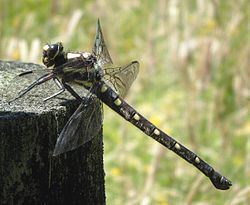Infraorder Anisoptera Order Odonate | Scientific name Uropetala carovei Rank Species | |
 | ||
Similar Uropetala, Antipodochlora braueri, Austrolestes colensonis, Melangyna novaezelandiae, Trigonospila brevifacies | ||
Uropetala carovei (New Zealand bush giant dragonfly) is a giant dragonfly of the family Petaluridae, endemic to New Zealand. Its Māori name, kapokapowai, means "water snatcher", alluding to the water dwelling larva, which, like all dragonflies, has a long extendable jaw that shoots out to snatch prey.
Contents
Description
Its yellow and black body can be up to 86 mm long, with a wingspan up to 130 mm, making it the largest dragonfly in New Zealand. Males have petal-shaped hind appendages. Uropetala carovei can be distinguished from the similar Uropetala chiltoni, which occurs in the mountains of the South Island, by its all-black labrum (lacking the large pale blotch on Uropetala chiltoni), and its brown to yellowish leg femur segments (which are black in Uropetala chiltoni).
Distribution
This species is found throughout New Zealand, mostly in western parts of each island, and especially on the West Coast. They are found in damp areas of native forest.
Ecology
The nymphs tunnel into the soft earth of a stream bank or seepage, where they occupy a chamber half-filled with water for about five years. They emerge at night to seek prey near the burrow entrance. They are sensitive to disturbance so are rarely observed.
A slow and noisy flier, its diet is smaller insects, including cicadas, which they can eat on the wing. U. carovei is preyed on in turn by rats, kingfishers and even wasps.
